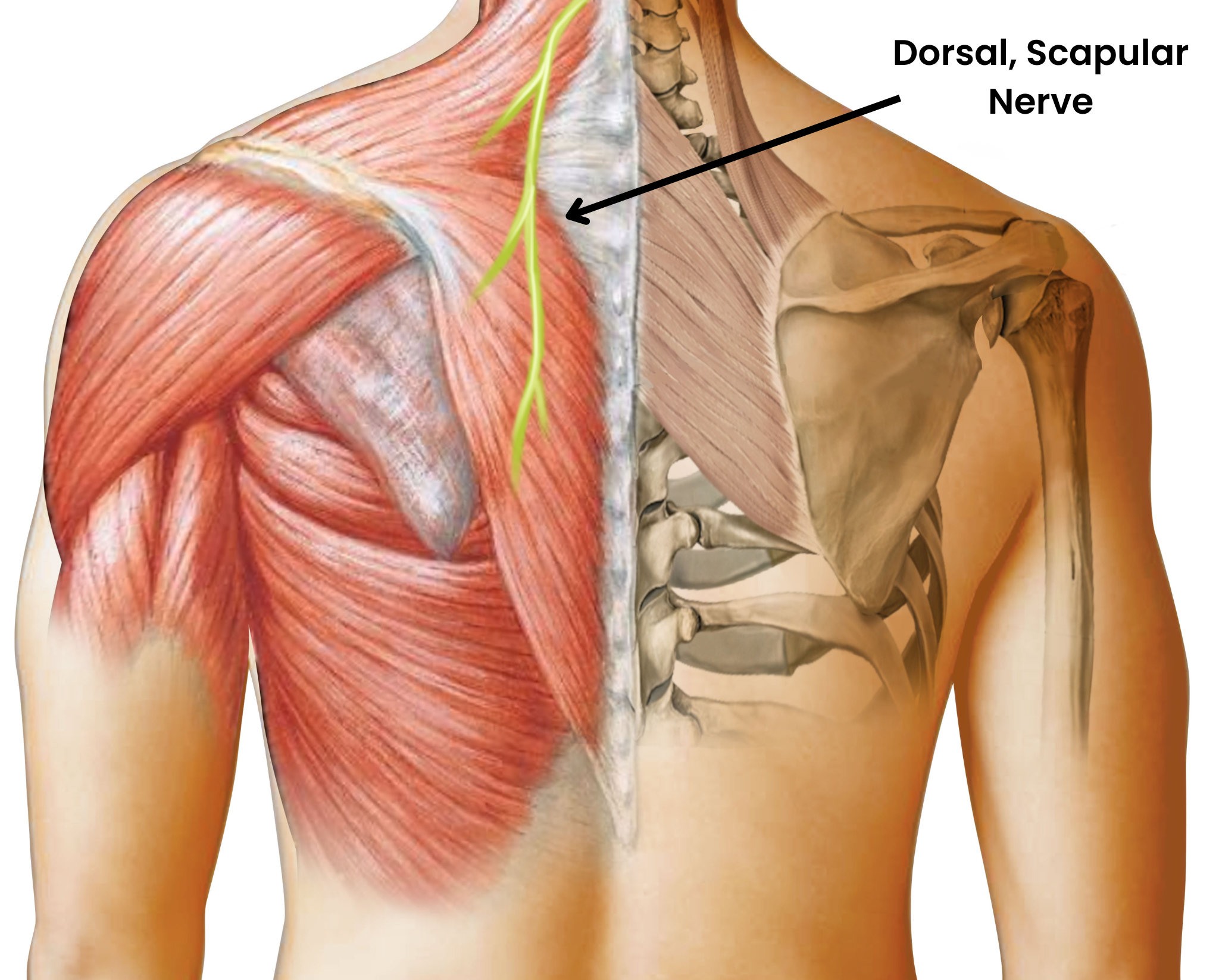Dorsal Scapular Neuropathy is More Common Than Expected
Reading time: 3 minutes
Misdiagnosing mid-back pain is common. Maigne suggests 70% of dorsal pain originates from the lower cervical spine. (1) If your next patient reports localized interscapular achiness, cramping, burning, or deep-seated painful tension in the scapular area, they should be screened for Dorsal Scapular Neuropathy (DSN). If you want to be a hero and stand out from other providers who focus on the site of pain, use the tests and treatments outlined in this blog.
“Manipulation of the thoracic facet and costovertebral joints is often met with temporary relief only and should tip the practitioner to a different primary cause of the intrathoracic pain.” (2)
What Is The Dorsal Scapular Nerve?
The dorsal scapular nerve’s primary function is to innervate the rhomboid major and minor. Injury, compression, or prolonged stretch of the nerve results in the inability to retract, elevate, and stabilize the scapula.
How To Recognize Dorsal Scapular Neuropathy (DSN)
Screening patients for DSN depends on the condition's intensity and duration. Acute presentations may have complete function and strength of the rhomboids. Chronic compression or long-standing injury may result in muscle atrophy. Depending on the severity, there are varying levels of pain intensity, compensatory muscle tightness, and rhomboid weakness. Here are some of the best ways for you to recognize DSN:
The patient describes numbness along the medial scapular border
a. Loss of cervical range of motion (Ipsilateral rotation, extension, and contralateral lateral flexion
Winging scapula upon inspection
Consistent point of pain just lateral to the spinous processes found with palpation between T5 and T6 in a large percentage of patients
Nocturnal pain: aggravated by prone sleeping with cervical rotation to the affected side.
Quick Test: Can your patient posteriorly tilt their scapula?
If they can't, then it's time to think about Dorsal Scapular Neuropathy (3)
Orthopedic Testing for Dorsal Scapular Nerve (DSN) Neuropathy
Pro Tip:
The pain usually decreases with rest; however, it may be aggravated during sleeping, especially if the patient's preferred position is prone with rotation to the affected side. (1)
Treatment of Dorsal Scapular Neuropathy
DSN treatment should focus on the cervical spine with modalities such as spinal manipulation, exercise, and soft tissue therapy to the thoracic and cervical spine musculature. (7,8) There are studies demonstrating the successful treatment of DSN with spinal manipulation of the cervical and thoracic spine, manual therapy to the scalenes, and strengthening of the rhomboids. (9)
-
1. Maigne R. Orthopedic Medicine: a New Approach to Vertebral Manipulations. Springfield, IL: Charles C. Thomas; 1972. pp. 255–266.
2. Muir B. Dorsal scapular nerve neuropathy: a narrative review of the literature. The Journal of the Canadian Chiropractic Association. 2017 Aug;61(2):128.
3. Frank DK, Wenk E, Stern JC, Gottlieb RD, Moscatello AL. A cadaveric study of the motor nerves to the levator scapulae muscle. Otolaryngol Head Neck Surg. 1997;117(6):671–80.
4. Ravindran M. Two cases of suprascapular neuropathy in a family. Br J Sports Med. 2003;37:539–541.
5. Akgun K, Aktas I, Terzi Y. Winged scapula caused by a dorsal scapular nerve lesion: a case report. Arch Phys Med Rehabil. 2008;89:2017–2020.
6. Brower RS. Differential diagnosis of cervical radiculopathy and myelopathy. In: Clark CR, editor. The Cervical Spine. 4th ed. Philadelphia: Lippincott Williams & Wilkins; 2005. pp. 995–1008.
7. Terrett AG, Terrett RG. Referred posterior thoracic pain of cervical posterior rami origin: a cause of much misdirected treatment. Chiropr J Austral. 2002;32(2):42–51.
8. Engel G, Gatterman M. Cervicogenic Dorsalgia. In: Gatterman M, editor. Foundations of Chiropractic: Subluxation. Elsevier Heatlh Sciences; 2005. pp. 448–456
9. Plezbert JA, Nicholson CV. Dorsal scapular nerve entrapment neuropathy: a unique clinical syndrome. J Neuromusculoskel System. 1994;2(4):206–211.





